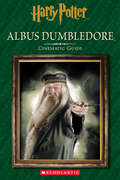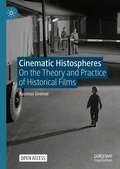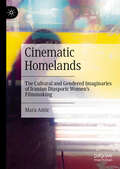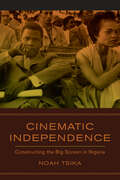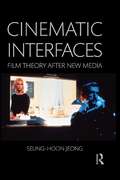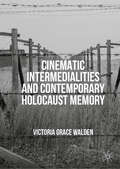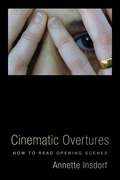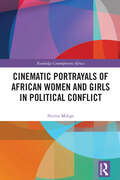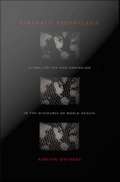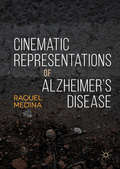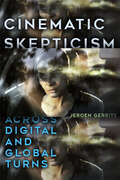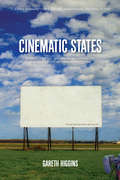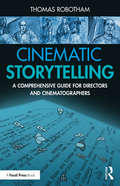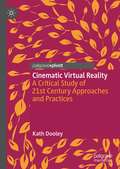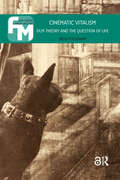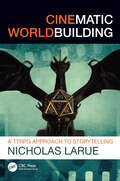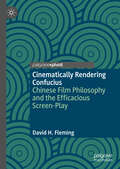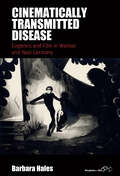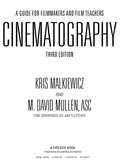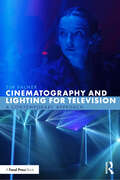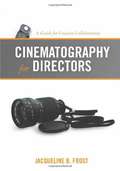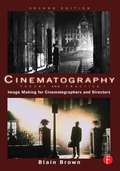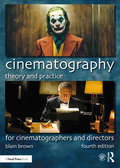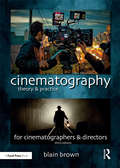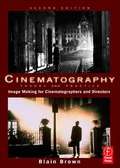- Table View
- List View
Cinematic Guide: Albus Dumbledore (Harry Potter)
by Felicity BakerThe Essential Film Companion for ALBUS DUMBLEDORE that's perfect for the youngest fans! This hardcover guidebook features your favorite scenes and quotes from all eight Harry Potter movies!The experience of this eBook will be best if viewed on a tablet.
Cinematic Histospheres: On the Theory and Practice of Historical Films
by Rasmus GreinerIn this Open Access book, film scholar Rasmus Greiner develops a theoretical model for the concept of the histosphere to refer to the “sphere” of a cinematically modelled, physically experienceable historical world. His analysis of practices of modelling and perceiving, immersion and empathy, experience and remembering, appropriation and refiguration, combine approaches from film studies, such as Vivian Sobchack’s phenomenology of film experience, with historiographic theories, such as Frank R. Ankersmit’s concept of historical experience. Building on this analysis, Greiner examines the spatial and temporal organization of historical films and presents discussions of mood and atmosphere, body and memory, and genre and historical consciousness. The analysis is based around three historical films, spanning six decades, that depict 1950s Germany: Helmut Käutner’s Sky Without Stars (1955), Jutta Brückner’s Years of Hunger (1980), and Sven Bohse’s three-part TV series Ku’damm 56 (2016).
Cinematic Homelands: The Cultural and Gendered Imaginaries of Iranian Diasporic Women’s Filmmaking
by Mara AnticThis book maps an emerging cycle of films made by Iranian diasporic women filmmakers and produced outside of Iran, focusing on five significant examples: Shirin Neshat’s Women Without Men (2009), Sepideh Farsi’s Red Rose (2014), Maryam Keshavarz’s Circumstance (2011), Ana Lily Amirpour’s A Girl Walks Home Alone at Night (2014) and Desiree Akhavan’s Appropriate Behaviour (2014). These films speak to the emergence of feminist concerns surrounding gender relations, female subjectivity and sexuality in diasporic filmmaking. The book intends to show how the body of recent Iranian diasporic women’s films demonstrates a substantial shift within the existing exilic and diasporic paradigm, requiring analysis of intersectional relations not only between ethnicity, culture and nationality, but also gender and sexuality. Attending closely to the vibrant feminist film culture generated by Iranian women in diaspora, this book aims to interrogate the diversity of women’s filmmaking practices and their role in shaping new representations of female subjectivity and the diasporic condition.
Cinematic Independence: Constructing the Big Screen in Nigeria
by Noah TsikaA free open access ebook is available upon publication. Learn more at www.luminosoa.org.Cinematic Independence traces the emergence, demise, and rebirth of big-screen film exhibition in Nigeria. Film companies flocked to Nigeria in the years following independence, beginning a long history of interventions by Hollywood and corporate America. The 1980s and 1990s saw a shuttering of cinemas, which were almost entirely replaced by television and direct-to-video movies. However, after 1999, the exhibition sector was revitalized with the construction of multiplexes. Cinematic Independence is about the periods that straddle this disappearing act: the immediate decades bracketing independence in 1960, and the years after 1999. At stake is the Nigerian postcolony’s role in global debates about the future of the movie theater. That it was eventually resurrected in the flashy form of the multiplex is not simply an achievement of commercial real estate, but also a testament to cinema’s persistence—its capacity to stave off annihilation or, in this case, come back from the dead.
Cinematic Interfaces: Film Theory After New Media
by Seung-hoon JeongIn this book, Seung-hoon Jeong introduces the cinematic interface as a contact surface that mediates between image and subject, proposing that this mediation be understood not simply as transparent and efficient but rather as asymmetrical, ambivalent, immanent, and multidirectional. Jeong enlists the new media term "interface" to bring to film theory a synthetic notion of interfaciality as underlying the multifaceted nature of both the image and subjectivity. Drawing on a range of films, Jeong examines cinematic interfaces seen on screen and the spectator’s experience of them, including: the direct appearance of a camera/filmstrip/screen, the character’s bodily contact with such a medium-interface, the object’s surface and the subject’s face as "quasi-interface," and the image itself. Each of these case studies serves as a platform for remapping and revamping major concepts in film studies such as suture, embodiment, illusion, signification, and indexicality. Looking to such theories as the ontology of the image and the phenomenology of the body, this original theorization of the cinematic interface not only offers a conceptual framework for rethinking and re-linking film and media studies, but also suggests a general theory of the interface.
Cinematic Intermedialities and Contemporary Holocaust Memory
by Victoria Grace WaldenThis book explores the growing trend of intermediality in cinematic representations of the Holocaust. It turns to the in-betweens that characterise the cinematic experience to discover how the different elements involved in film and its viewing collaborate to produce Holocaust memory. Cinematic Intermedialities is a work of film-philosophy that places a number of different forms of screen media, such as films that reassemble archive footage, animations, apps and museum installations, in dialogue with the writing of Deleuze and Guattari, art critic-cum-philosopher Georges Didi-Huberman and film phenomenologies. The result is a careful and unique examination of how Holocaust memory can emerge from the relationship between different media, objects and bodies during the film experience. This work challenges the existing concentration on representation in writing about Holocaust films, turning instead to the materials of screen works and the spectatorial experience to highlight the powerful contribution of the cinematic to Holocaust memory.
Cinematic Overtures: How to Read Opening Scenes (Leonard Hastings Schoff Lectures)
by Annette InsdorfA great movie’s first few minutes provide the key to the rest of the film. Like the opening paragraphs of a novel, they draw the viewer in, setting up the thematic concerns and stylistic approach that will be developed over the course of the narrative. A strong opening sequence leads the viewer to trust the filmmakers. Other times, opening shots are intentionally misleading as they invite alert, active participation with the film. In Cinematic Overtures, Annette Insdorf discusses the opening sequence so that viewers turn first impressions into deeper understanding of cinematic technique.From Joe Gillis’s voice-over in Sunset Boulevard as he lies dead in a swimming pool to the hallucinatory opening of Apocalypse Now, from the stream-of-consciousness montage as found in Hiroshima, mon amour to the slowly unfolding beginning of Schindler’s List, Cinematic Overtures analyzes opening shots from a range of Hollywood as well as international films. Insdorf pays close attention to how the viewer makes sense of these scenes and the cinematic world they are about to enter. Including dozens of frame enlargements that illustrate the strategies of opening scenes, Insdorf also examines how films explore and sometimes critique the power of the camera’s gaze. Along with analyses of opening scenes, the book offers a series of revelatory and surprising readings of individual films by some of the leading directors of the past seventy-five years. Erudite but accessible, Cinematic Overtures will lead film scholars and ardent movie fans alike to greater attentiveness to those fleeting opening moments.
Cinematic Portrayals of African Women and Girls in Political Conflict (Routledge Contemporary Africa)
by Norita MdegeThis book provides an interdisciplinary exploration of the cinematic representations of the experiences of African women and girls in situations of political conflict. The role of cinema is important in providing information about the situation of women and girls in situations of political conflict, and the main characters often also become signifiers of wider social, political and economic ideas, at both global and local levels. Drawing on fictional and biographical cinematic representations, this book considers films covering a range of different regions, experiences, historical periods and other contexts, to draw a nuanced picture of African women and girls who participate in or are affected by African political conflicts. The films are analysed using a decolonial feminist cultural approach, which combines cultural approaches, African feminisms and the contrapuntal method to ensure an inter-textual, intersectional and decolonial examination. The book engages with multiple themes and topics, including nationalism, nation-building, neocolonialism, memory, history, women’s and girls’ agency and activism. Through these themes and topics, the book explores how the films represent African women’s and girls’ agency in relation to their participation in social, economic and political activities. This book will make a significant contribution to literature focused on African women and girls within politics, conflict studies and film studies.
Cinematic Prophylaxiscine: Globalization and Contagion in the Discourse of World Health
by Kirsten OstherrA timely contribution to the fields of film history, visual cultures, and globalization studies, Cinematic Prophylaxis provides essential historical information about how the representation of biological contagion has affected understandings of the origins and vectors of disease. Kirsten Ostherr tracks visual representations of the contamination of bodies across a range of media, including 1940s public health films; entertainment films such as 1950s alien invasion movies and the 1995 blockbuster Outbreak; television programs in the 1980s, during the early years of the aids epidemic; and the cyber-virus plagued Internet. In so doing, she charts the changes--and the alarming continuities--in popular understandings of the connection between pathologized bodies and the global spread of disease. Ostherr presents the first in-depth analysis of the public health films produced between World War II and the 1960s that popularized the ideals of world health and taught viewers to imagine the presence of invisible contaminants all around them. She considers not only the content of specific films but also their techniques for making invisible contaminants visible. By identifying the central aesthetic strategies in films produced by the World Health Organization, the Centers for Disease Control, and other institutions, she reveals how ideas about racial impurity and sexual degeneracy underlay messages ostensibly about world health. Situating these films in relation to those that preceded and followed them, Ostherr shows how, during the postwar era, ideas about contagion were explicitly connected to the global circulation of bodies. While postwar public health films embraced the ideals of world health, they invoked a distinct and deeply anxious mode of representing the spread of disease across national borders.
Cinematic Representations of Alzheimer’s Disease
by Raquel MedinaThis book offers a cross-cultural approach to cinematic representations of Alzheimer’s disease in non-mainstream cinema. Even though Alzheimer’s disease, the most common form of dementia, is a global health issue, it is not perceived or represented homogenously around the world. Contrary to very well-known mainstream films, the films discussed do not focus on the negative aspects normally associated with Alzheimer’s disease, but on the importance of portraying the perspective of the persons living with Alzheimer’s and their personhood. Similarly, this book analyses how the films use Alzheimer’s as a trope to address issues relating to different areas of life and society such as, for example, family matters, intergenerational relationships, gender issues, national traditions versus global modernity, and caring for people with dementia. By examining an array of films, from crime fiction to documentary, that each present non-stigmatising representations of Alzheimer’s disease, this in-depth study ultimately demonstrates the power of culture in shaping meaning.
Cinematic Skepticism: Across Digital and Global Turns
by Jeroen GerritsBecause of its automatic way of recording reality, film has a privileged relation to the problem of skepticism. If early film theorists celebrate cinema for overcoming skeptical doubt about the power of human vision, recent film-philosophers argue that our postphotographic, digital cinema is heading toward a general acceptance of skepticism, as though nothing on screen has anything to do with reality any longer. Emerging from the interaction of Stanley Cavell's and Gilles Deleuze's film-philosophies, Cinematic Skepticism challenges both these views. Jeroen Gerrits takes the issue of skepticism beyond concern with knowledge, turning skepticism into an ethical problem that pervades film history and theory. At the same time, he rethinks a Cavello-Deleuzian approach across the digital and global turns in cinema. Combining clear explanations of complex philosophical arguments with in-depth analyses of the contemporary films Grizzly Man, Amélie, Three Monkeys, and The Headless Woman, Gerrits traces how cinema invents ways of dis/connecting to the world.
Cinematic States: Stories We Tell, the American Dreamlife, and How to Understand Everything*
by Gareth HigginsA Northern Irish writer explores his adopted homeland through film in this irreverent yet moving journey through each of the 50 states. Set among a personal backdrop of immigration memoir, he takes on American myths in their most powerful form--the motion picture--by setting out to determine if a Kansas yellow brick road really does lead to the end of the rainbow, and whether it first has to pass through Colorado's Overlook Hotel. Amid the multipurpose woodchippers, friendly exorcists, and faulty motel showers, resurrected baseball players, and miracle-working gardeners, he examines what the stories we tell reveal about American lives and uses this to sum up what he has learned about the promises, failures, and hope that is America.
Cinematic Storytelling: A Comprehensive Guide for Directors and Cinematographers
by Thomas RobothamThis book presents a new, story-based approach to cinematic coverage and storytelling in film and video. It breaks from the conventional idea that shots are the fundamental unit of filmmaking, instead exploring the specifics of determining coverage. Keyframes in patterns are introduced, delivering scripted material in a context-rich presentation that supports the storytelling. All the analysis, interpretation, and creative decision making is done first, with shots derived as the very last step. Scripted material is divided into six categories with associated patterns. Like cinematic building blocks, these can freely stack up and interconnect, supporting creativity and avoiding rigid formulas. This approach enables filmmakers to tap into the film "language" that audiences already understand and put it to practical use, helping the audience to feel the storytelling deeply. Dozens of film examples are provided throughout, plus conceptual and camera diagrams to contextualize the methods presented, and exercises are provided to reinforce concepts. Emphasis is placed on supporting performance and story meaning through a cinematic context. With all the concepts and decision-making options described and shown in examples, a scripted scene is analyzed and developed through an eight-step process, illustrated with storyboard, camera diagrams, and ultimately shot list descriptions. The book is ideal for filmmaking students interested in directing and cinematography, as well as aspiring and early-career filmmakers, cinematographers, and directors.
Cinematic Virtual Reality: A Critical Study of 21st Century Approaches and Practices
by Kath DooleyWith reference to traditional film theory and frameworks drawn from fields such as screenwriting studies and anthropology, this book explores the challenges and opportunities for both practitioners and viewers offered by the 360-degree storytelling form. It focuses on cinematic virtual reality (CVR), a format that involves immersive, high quality, live action or computer-generated imagery (CGI) that can be viewed through head mounted display (HMD) goggles or via online platforms such as YouTube. This format has surged in popularity in recent years due to the release of affordable high quality omnidirectional (360-degree) cameras and consumer grade HMDs. The book interrogates four key concepts for this emerging medium: immersion, presence, embodiment and proximity through an analysis of innovative case studies and with reference to practitioner interviews. In doing so, it highlights the specificity of the format and provides a critical account of practitioner approaches to the concept development, writing and realisation of short narrative CVR works. The book concludes with an account of the author’s practice-led research into the form, providing a valuable example of creative practice in the field of immersive media.
Cinematic Vitalism: Film Theory and the Question of Life (Film Theory in Media History)
by Inga PollmannThis book argues that there are constitutive links between early twentieth-century German and French film theory and practice, on the one hand, and vitalist conceptions of life in biology and philosophy, on the other. By considering classical film-theoretical texts and their filmic objects in the light of vitalist ideas percolating in scientific and philosophical texts of the time, Cinematic Vitalism reveals the formation of a modernist, experimental and cinematic strand of vitalism in and around the movie theater. The book focuses on the key concepts including rhythm, environment, mood, and development to show how the cinematic vitalism articulated by film theorists and filmmakers maps out connections among human beings, milieus, and technologies that continue to structure our understanding of film. This book draws new connections between twentieth-century German and French film theory and practice and vitalist conceptions of life from biology and philosophy.
Cinematic Worldbuilding: A TTRPG Approach to Storytelling
by Nicholas LaRueEverybody has a story in them. Some people lack the language and the tools to tell that story effectively. As an avid tabletop role-playing game player, I’m amazed at people’s ability to tell stories on the spot. Both the players and the game masters are creating worlds in their minds and playing out the events, using improv, in real-time. Being an author and screenwriter, I know how difficult it is to create consistent and well-constructed characters, themes, and conflicts. I believe that storytellers looking to level up in the classroom, their hobby, or career could learn a lot from games like Dungeons & Dragons, Pathfinder, and others. This book seeks to give people the tools and language to create and master their worlds and characters, using TTRPG mechanics and rulesets as foundational elements. This book will contain insights and interviews from some of today’s most respected game masters, players, actual play actors, and we’ll also hear from some of the people behind the scenes responsible for creating these games, and how they view worldbuilding and storytelling for their audiences.
Cinematically Rendering Confucius: Chinese Film Philosophy and the Efficacious Screen-Play
by David H. FlemingCinematically Rendering Confucius marks the first book-length enquiry into China’s first two big screen treatments of arguably the best-known and most influential thinker in world history: Confucius. By interweaving methods drawn from Film Studies, Comparative Philosophy, and Media Archaeology in response to broader calls to deepen and thicken the scope and purview of film philosophical enquiry, this trailblazing book grounds Fei Mu’s 1940 patriotic art film Kǒng Fūzǐ and Hu Mei's 2010 “Huallywood” blockbuster Kǒngzǐ as pre- and postsocialist examples of Chinese politico-philosophical filmmaking that straddle the PRC’s revolutionary Marxist socio-political experiment. After exploring the geopolitics surrounding why Confucius has been historically included and excluded from the European classification of “philosopher” and addressing the difficulties that entering into “Chinese Thought” presents to non-natives, the book’s first half undertakes a deep dive into the history of (re)mediating the Confucian image-imagination. Arguing that Confucius might be a form of film philosopher avant la lettre, we thereafter explore repetitions and differences surrounding the ever-changing treatment and representation of Confucius on-screen—concluding with a look at the latest AI-infused theory-film When Marx Met Confucius (2023).
Cinematically Transmitted Disease: Eugenics and Film in Weimar and Nazi Germany (Film Europa #28)
by Barbara HalesPropaganda played an essential role in influencing the attitudes and policies of German National Socialism on racial purity and euthanasia, but little has been said on the impact of medical hygiene films. Cinematically Transmitted Disease explores these films for the first time, from their inception during the Weimar era and throughout the years to come. In this innovative volume, author Barbara Hales demonstrates how medical films as well as feature films were circulated among the German people to embed and enforce notions of scientific legitimacy for racial superiority and genetically spread “incurable” diseases, creating and maintaining an instrumental fear of degradation in the German national population.
Cinematography
by Kris Malkiewicz M. David MullenThe Essential Guide to the Cameraman's Craft Since its initial publication in 1973, Cinematography has become the guidebook for filmmakers. Based on their combined fifty years in the film and television industry, authors Kris Malkiewicz and M. David Mullen lay clear and concise groundwork for basic film techniques, focusing squarely on the cameraman's craft. Readers will then learn step-by-step how to master more advanced techniques in postproduction, digital editing, and overall film production. This completely revised third edition, with more than 200 new illustrations, will provide a detailed look at: How expert camera operation can produce consistent, high-quality results How to choose film stocks for the appearance and style of the finished film How to measure light in studio and location shooting for the desired appearance How to coordinate visual and audio elements to produce high-quality sound tracks Whether the final product is a major motion picture, an independent film, or simply a home video, Cinematography can help any filmmaker translate his or her vision into a quality film.
Cinematography and Lighting for Television: A Contemporary Approach
by Tim PalmerDrawing from author Tim Palmer's 30 years of experience working as a cinematographer for award-winning drama series including Killing Eve, Bad Sisters, and Line of Duty, this book is the go-to guide on how to light just about any scene a cinematographer may face when shooting a TV show.Focusing on lighting scenarios suitable for the small screen, the book is thematically organised into night and day, exteriors and interiors, and special situations including magic hour, candlelight and firelight, moonlight, torchlight, vehicle interiors, and green/blue screen, as well as providing examples from within the studio for each of these settings. Using the latest technology and developments in the practice, Palmer illustrates how cinematographers can effectively use lighting within a variety of situations. Palmer works through each example by illustrating and describing the setup with the corresponding finished film frames to show the final effect of the lighting achieved so cinematographers can easily apply and translate it to their own work.Including practical advice for working in the industry and tips for low-budget and student settings, this is an accessible and creative guide to producing visually compelling footage that translates the script to the screen. Ideal for the professional cinematographer and advanced students of cinematography looking to develop their skills.
Cinematography for Directors: A Guide for Creative Collaboration
by Jacqueline B. FrostThe essential handbook for directors and aspiring filmmakers who want to get the best visuals for their films while establishing a collaborative relationship with their cinematographer. This is the only book that focuses exclusively on the relationship between the director and cinematographer.
Cinematography, Theory and Practice: Image Making for Cinematographers and Directors (Second Edition)
by Blain BrownThere's more to being a DP than holding a light meter! With this book as your guide, you are on your way to learning not only about the equipment and technology, but also about the concepts and thought processes that will enable you to shoot professionally, efficiently, and with artistic mastery. A leading book in the field, Cinematography has been translated into many languages and is a staple at the world's top film schools. Lavishly produced and illustrated, it covers the entire range of the profession. The book is not just a comprehensive guide to current professional practice; it goes beyond to explain the theory behind the practice, so you understand how the rules came about and when it's appropriate to break them. In addition, directors will benefit from the book's focus on the body of knowledge they should share with their Director of Photography. Cinematography presents the basics and beyond, employing clear explanations of standard practice together with substantial illustrations and diagrams to reveal the real world of film production. Recognizing that professionals know when to break the rules and when to abide by them, this book discusses many examples of fresh ideas and experiments in cinematography. Covering the most up-to-date information on the film/digital interface, new formats, the latest cranes and camera support and other equipment, it also illustrates the classic tried and true methods. New! A DVD and website features hours of video footage, offering key instruction in topics such as camera basics and essentials, lighting, shooting methods, and much more. Topics include: Concepts of filmmaking, Language of the lens, Cinematic continuity, Lighting for film, digital, and HD, Exposure HD cinematography and shooting, Shooting in HD, Image control and filters, Bleach bypass processes, Lighting as storytelling, Shooting special effects, Set procedures and other issues. The DVD files are also available at http://www. taylorandfrancis. com/cw/brown-9780240812090/.
Cinematography: For Cinematographers and Directors
by Blain BrownThis book covers both the artistry and craftsmanship of cinematography and visual storytelling. Few art forms are as tied to their tools and technology as is cinematography. Take your mastery of these new tools, techniques, and roles to the next level with this cutting-edge roadmap from author and filmmaker Blain Brown. This 4th edition has been thoroughly updated throughout to include detailed information on the latest lighting and camera equipment, as well as expanded and updated discussion on the following areas: shooting on a budget, color spaces with emphasis on the new UHD standards, the decision-making process in choosing what lights and equipment to use, considerations concerning power issues, safety and what electrical supply is needed for various types of lights, an examination of the cinematographer’s role in preproduction, and much more. Topics Include: • Visual storytelling • Continuity and coverage • Cameras and digital sensors • The tools and basics of film lighting • Methods of shooting a scene • Continuity and coverage • Exposure • Color • Understanding digital images • Using linear, gamma, and log video • Image control and grading on the set • Data management and the DIT • Optics and focus • Camera movement • Set operations • Green screen, high speed, and other topics.Whether you are a student of filmmaking, someone just breaking into the business, working in the field and looking to move up the ladder, or an experienced filmmaker updating your knowledge of tools and techniques, this book provides both the artistic background of visual language and also the craft of shooting for continuity, lighting tools and methods, and the technical side of capturing images on digital or on film. The companion website (www.routledge.com/cw/brown) features additional material, including lighting demonstrations, basic methods of lighting, methods of shooting a scene, using diffusion, and other topics.
Cinematography: Image Making for Cinematographers and Directors
by Blain BrownThe world of cinematography has changed more in the last few years than it has since it has in 1929, when sound recording was introduced. New technology, new tools and new methods have revolutionized the art and craft of telling stories visually. While some aspects of visual language, lighting and color are eternal, shooting methods, workflow and cameras have changed radically. Even experienced film artists have a need to update and review new methods and equipment. These change affect not only the director of photography but also the director, the camera assistants, gaffers, and digital imaging technicians. Cinematography: Theory and Practice covers both the artistry and craftsmanship of cinematography and visual storytelling. Few art forms are as tied to their tools and technology as is cinematography. Take your mastery of these new tools, techniques, and roles to the next level with this cutting-edge roadmap from author and filmmaker Blain Brown. Whether you are a student of filmmaking, just breaking into the business, currently working in the industry and looking to move up to the next level, or an experienced professional who wants to update their knowledge of tools and techniques, this book provides both a basic introduction to these issues as well as more advanced and in-depth coverage of the subject. The companion website features additional material, including lighting demonstrations, basic methods of lighting, using diffusion and other topics. Topics Include: Visual language Visual storytelling Continuity and coverage Cameras and digital sensors Exposure techniques for film and video Color in-depth Understanding digital images Waveform monitors, vectorscopes, and test charts Using linear, gamma, and log encoded video Image control and grading on the set The tools and basics of film lighting ASC-CDL, ACES and other new methods Optics and focus Camera movement Set operations Green screen, high speed and other topics
Cinematography: Theory and Practice
by Blain BrownThere's more to being a DP than holdng a light meter! With this book as your guide, you are on your way to learning not only about the equipment and technology, but also about the concepts and thought processes that will enable you to shoot professionally, efficiently, and with artistic mastery. A leading book in the field, Cinematography has been translated into many languages and is a staple at the world's top film schools. Lavishly produced and illustrated, it covers the entire range of the profession. The book is not just a comprehensive guide to current professional practice; it goes beyond to explain the theory behind the practice, so you understand how the rules came about and when it's appropriate to break them. In addition, directors will benefit from the book's focus on the body of knowledge they should share with their Director of Photography.Cinematography presents the basics and beyond, employing clear explanations of standard practice together with substantial illustrations and diagrams to reveal the real world of film production. Recognizing that professionals know when to break the rules and when to abide by them, this book discusses many examples of fresh ideas and experiments in cinematography. Covering the most up-to-date information on the film/digital interface, new formats, the latest cranes and camera support and other equipment, it also illustrates the classic tried and true methods.
